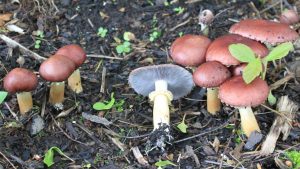#146: Gliophorus psittacinus, the Parrot Mushroom [Archived]
Note: This is an archived post. The current version of this post is available here. This is a beautiful little waxy cap that displays one of the most striking color changes of all mushrooms. Gliophorus psittacinus is easily identified by its slimy texture and bright green color that becomes yellow as the mushroom matures. Because the color fades, older specimens are easily confused with the many other yellowish waxy caps. For easy identification of this mushroom, you really need to find young specimens that are still green and slimy. As with other waxy caps, the flesh has a texture reminiscent of candle wax. However, to experience this, one would first have to get past the considerable sliminess of the cap and stipe. Because of its initial bright green color (which one might term “parrot green”), G. psittacinus is commonly called the “Parrot Mushroom” or “Parrot Waxcap.” Indeed, the root word...

![#146: Gliophorus psittacinus, the Parrot Mushroom [Archived]](https://www.fungusfactfriday.com/wp-content/themes/hueman/assets/front/img/thumb-medium-empty.png)





![#011: Characteristics of Kingdom Fungi [Archived]](https://www.fungusfactfriday.com/wp-content/themes/hueman/assets/front/img/thumb-small-empty.png)

